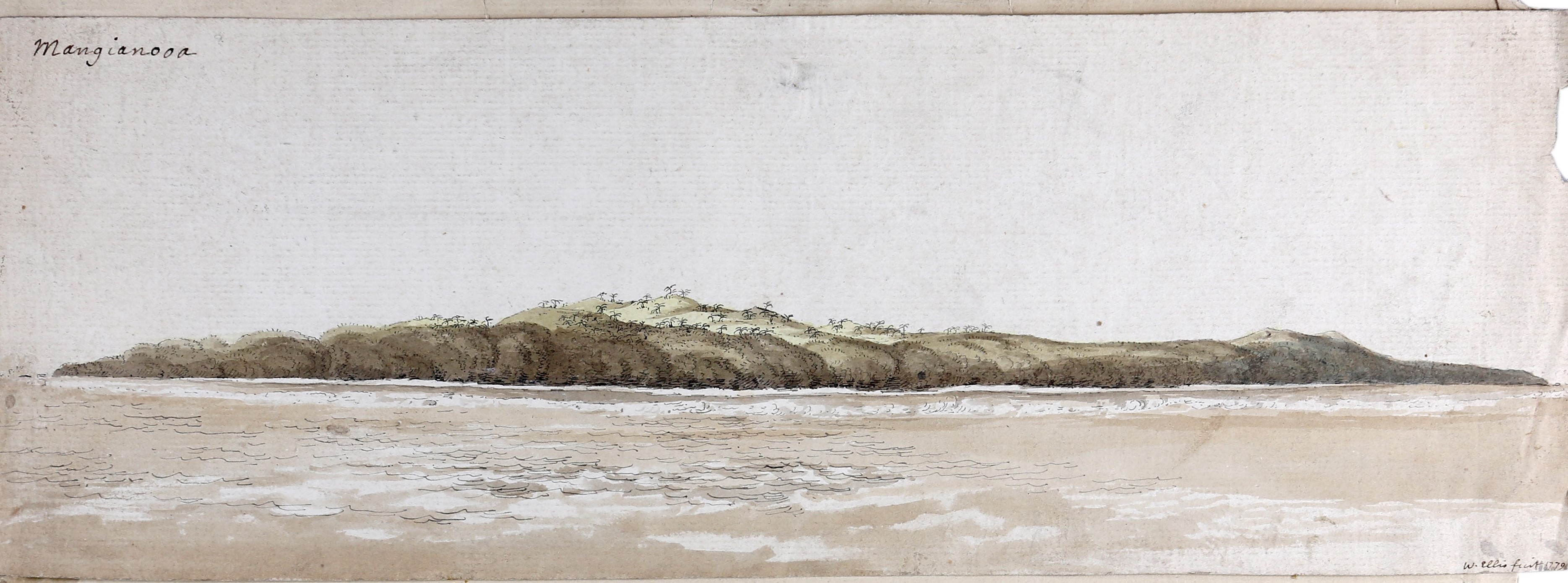

James Cook, the controversial British explorer, navigator, cartographer, and captain in the British Royal Navy, undertook three famous voyages to the Pacific Ocean, with the third and final voyage instructed by the Admiralty ending in Cook’s untimely death. During these intrepid voyages, many sketches and drawings were made of the ship's discoveries. In no less dramatic circumstances, this voyage of discovery has been repeated 240 years later by Chiswick Auctions’ Rhydian Williams, Specialist in the Books & Works on Paper Department. Rhydian talks us through his discovery of this beautiful watercolour of the island of Mangaia and its historical importance today.
To understand the watercolour we can first turn to the Surgeon’s Mate on HMS Discovery, William Wade Ellis’ account of James Cook’s Third Voyage. Here he describes the Island of Mangaia, the most southerly of the modern-day Cook Islands, as it appeared in 1777:
“[...] we discovered land bearing about N. E. [...] At four we were running along the south side, at about the distance of four miles, which as the sun was just rising, afforded a most pleasing prospect. The interior parts rose in moderately high hills, upon the tops of which were trees of various kinds. The sides next to the sea were very woody, and we could plainly distinguish cocoa-nut and plantain trees in abundance. — Upon our nearer approach to the shore, we saw many of the natives running along the beach, and, by the help of our glasses, found that some had large clubs upon their shoulders and that others were armed with long spears. As we proceeded, the Indians followed us, shouting and hallooing, their number increasing very fast. Soon after two of them put off in a canoe (the only one we saw), and came within fifty or sixty yards of the ships, but would not venture nearer, though we made all the friendly sign we could think of, and shewed them beads, hatchets, looking-glasses, and many other articles of Indian trade. Their complexion appeared to be of the dark olive call, their hair was fastened on the top of their heads something in the New Zealand fashion...”
As evocative as his description is, Ellis, who was Surgeon’s Mate and an amateur artist on board the Discovery, would also have recorded the scene visually, with a field sketch. Two years later, presumably very soon after Cook had been speared to death and subsequently ‘baked’ by uncooperative Hawaiians, Ellis used these sketches as the basis for a watercolour view, see above.
I came across the watercolour in a large consignment of four folders, where it had lain nestled amongst a rather tattered group of prints and drawings ever since it was inherited by the vendor in the 1980s. I was particularly Intrigued by the date, inscription and a landscape too tropical to be Surrey, so I kept it aside for further research.
I discovered that the work, which is coming up for auction on the 31 March, is the first work by Ellis from the voyage to have ever come up for auction. Its rarity is illustrated by the fact that comparable examples are only to be found in institutions such as the National Maritime Museum, The National Library of New Zealand and the Hocken Library in Otago.
The piece has been generated interest on the other side of the globe. Anthony Whyte, the executive officer of Mangaia, is supporting calls for the government to purchase Williams Wade Ellis’ painting at auction, and bring it back to Cook Islands. “My opinion is it’s worth purchasing. especially since it was on Cook’s third voyage and his last,” Whyte argues.
At the Ministry of Culture in Rarotonga, Culture secretary Anthony Turua agrees. He says he was surprised and pleased to read of the discovery. “It is inspirational to have this painting recognising its originality of the island of Mangaia and the artist from the United Kingdom,” says Turua. The Ministry of Culture doesn’t have a policy around procuring images by external artists – but he will ask his officials to investigate whether this might be possible.“I am happy to have our office conduct research on how we can envisage the procurement of such identity from abroad.”
Dr Rod Dixon, the former director of the University of the South Pacific Cook Islands campus, also identifies the historical interest in the work. Back in 1777, the encounter made a lasting cultural impression on both the peoples of Mangaia and of England. The HMS Discovery’s stay at Mangaia was short, says Rod Dixon, but the sailors were not forgotten. The Mangaia leader Mourua, who had come on board and spoken with the crew, was a competent anthropologist himself. He and his fellows sketched their own impressions of the European visitors. And more than 50 years before the arrival of the missionaries, a new word entered the Mangaia language to describe these men of Britain. They were the “Beretane”.
Lot 411. Third voyage of James Cook.- Ellis (William Wade) Mangianooa [Mangaia, Cook Islands] will feature in our upcoming Books & Works on Paper including Autographs & Memorabilia